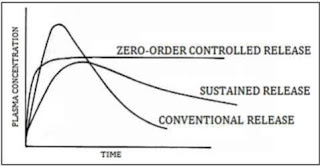pharmaceutical Technology-2
(a)
What are the reasons for tablet coating?
Given
below the major reason for tablet coating ---
1.
To
protect the
ingredient from environment
particularly from light, air and moisture.
2.
To mask the disagreeable taste, odor and
color of the drug.
3.
To
provide physical and
chemical protection to the drug.
4.
To
control the release
profile of the drug form the tablet.
5.
To
protect the drug form the gastric
environment of the stomach, or to escape the irritating action of the
drug to the stomach by using an acid resistant enteric coating.
6.
To incorporate another drug or adjuvant in
a coating to avoid chemical incompatibilities or to provide sequential drug
release.
7.
To improve the pharmaceutical elegance by the use of
special color coating.
8.
To facilitate handling especially
during packaging and filling.
9.
To improve product identity by the
manufacturer.
(b) What coating is needed for a tablet to make it waterproof?
Sugar
coating is an aquous process during which the tablet core is thoroughly wetted
by sugar solution; so sealing is the mandatory step in sugar coating. Sealing
is also called water proofing. It is essential for separating the tablet
ingredient and water in order to assure the good product stability.
The
necessity of sealing is also strengthening the tablet core. Sealents are
usually the alcoholic solution of resin. Example: Shellac, Zein, CAP, PAP.
Shellac: It is a
resinous secretion of lac insect (Laccifer lacca). Shellac is an
effective sealent but tablet disintegration and dissolution time tend to
lengthen on aging because of polymerization of Shellac.
Zein: Alcohol soluble protein derivative obtained from corn.
PAP
& CAP:
Cellulose acetate phthalate and polyvinyl acetate phthalate used enteric coated
tablet.
2(a) Discuss about various processing
problems encountered in the preparation of
tablet?
In
the process of developing formulation and in routine manufacturing of tablet,
various problems occur. Sometimes the source of problem is ---
•
Formulation
problem.
•
Faults
in compression equipment.
•
Sometimes
combination of above two
The formulation defects of tablets are as follows ---
1.
Capping
and lamination.
2.
Picking
and sticking.
3.
Mottling.
4.
Weight
variation.
5.
Hardness
variation.
6. Double impression
(b) What are the similarities and dissimilarities between compression coating and sugar coating?
Given
below the similarities and dissimilarities between compression coating and sugar coating:
|
Dissimilar |
Similar |
|
|
compression coating |
sugar coating |
|
|
Used
for heat sensitive drug. |
Can
not be use for heat sensitive drug. |
But
both form a coating on the tablet. |
|
Final
products are lighter, smaller, there by easier to swallow. |
Final
products are heavier.. |
Both
coating increase he tablet’s mass. |
|
Less
coating materials are needed.
|
More
coating materials are needed.
|
coating
materials are needed for both types of coating. |
|
Less
expensive to package and shipment.
|
Relatively
more expensive to package and shipment.
|
Both
are expensive than uncoated tablet. |
|
Process
can be automated.
|
Process
can be manual.
|
More
coating steps than uncoated tablet. |
|
|
|
|
What is the difference between sugar coating and
film coating:
|
Sugar coating |
Film coating |
|
Sugar coating involves the deposition of
sucrose solution onto the tablet. |
Film coating involves the deposition of
thin polymeric film. |
|
Sugar coating is an oldest method. |
It is newly developed method. |
|
This process arrow in the middle of 19th century. |
Film coated was first marketed by Abbott
company in 1953. |
|
The tablet appearance of sugar coating
is rounded with high degree of polishing. |
Film coated tablet are not usually as
shiny as sugar coated tablet and it can retain the contour of original core. |
|
In case of sugar coating (30-55) % of
original weight of the tablet may increase. |
Weight increase due to film coating is
(2-3) %. |
|
Logo or break line cannot appear through
sugar coating. |
Logo or break line can appear through
sugar coating. |
|
Considerable or special operator training
is required for sugar coating. |
This process lends itself automation and
operator training is easy. |
|
Sugar coating is a multistage process. |
It is usually a single stage process. |
|
Example: Sugar syrup, Zein, Shellac,
Polymer (PEG, HPEC, HPMC) etc. |
Example: Na-CMC, CAP, PAP, HPMCP, HPMC
etc. |
3(a)
Define granulation. Why it is necessary?
Granulation
is the process in which powder particles are made to adhere to form larger
particle or granule.
Necessities of granulation (Why granulation is
necessary?)
Granulation
is necessary because ---
1.
Primarily
to prevent the segregation on the powder mix.
2.
To
improve the flow property.
3.
To
enhance the compression characteristics.
4.
The
granulation of toxic material will reduce the hazard of the granulation.
5.
Materials
are slightly hydroscopic may adhere in the form of a cake if stored as a
powder. Granulation can prevent the formation of cake.
6.
Granules
being denser than the parent powder mix occur less volume per weight. They are
therefore more convenient for storage or shipment.
Why disintegrants are incorporated in
two steps during tablet manufacturing?
Illustrate Air Suspension method for
tablet coating.
What is the Necessities of excipients?
Excipients
plays a wide variety of functions in pharmaceutical dosage form including ---
•
They
provide the drug products delivery system. They transport the active drug to
the site in the body where the drug is intended to exert its action.
•
Excipients
will keep the drug from being released too early in assimilation process in
places where it could damage tender tissue and create gastric irritation or stomach
upset.
•
Some
excipients help the drug to disintegrate into particles small enough to reach
the blood stream more quickly and effectively at the time of use.
•
Some
excipients modulate stability and bioavailability of APIS (Active
pharmaceutical ingredients).
•
Helping
the active ingredient to maintain preferred polymorphic forms or conformations.
•
Excipients
are used to maintain the pH or osmolarity of liquid formulation.
•
Some
excipients are used to aid the identification of drug product.
•
Some
are important in the formulation of drug simply to make the product taste and
look better which improved patient’s compliance especially in children.
• In many products excipients make the bulk of the dosage form.
5(a) Why smoothing step in sugar coating is alternatively named syruping?
Syruping
or smoothing:
The purpose of this step is to cover and fill in the imperfection on the tablet
surface caused by the sub coating step. Smoothing usually is accomplished by
the successive application of dilute syrup, often the smoothy syrup contain a
few percentage of Titanium Dioxide as a opacifier.
(b) Mention the common problems associated
with sugar coated tablet .
Problems/defects
of sugar coating tablet:
1.
Chipping
of the coating tablet,
2.
Cracking,
3.
Soft
core due to non-drying coating,
4.
Winning
or the buildup multiple,
5.
Mottling,
6.
Blooming
or sweating,
7. Marbeling.
7. Diagrammatically represent the most popular technique of coating.
Film
coating involves the deposition, usually by a spraying method, of a thin
polymer formulation surrounding a tablet. Film coating is newly developed
method. Film coating tablet was first marketed in 1953 by Abbott Company. Film coating is the most popular technique
and virtually all new coated products introduced to the market are film coated.
Film coated tablets are usually as shiny as sugar coated tablet and it retain the content of original core. Weight increases due to the film coating is 2-3% that is negligible. It is possible to appear original core. This process lends itself to automation and operator training is easier. Film coating is usually a single stage process. Film coated tablet: The deposition of thin membrane which consists of polymer (thickness 20-200µ) plasticizer & their derivatives.
Mechanism of film coating: Film formulation generally comprise in 5
steps:
•
Spraying
of coating,
•
Deposition
of droplets over tablet surface,
•
Coalescence
of polymer droplet,
•
Removal
of solvent & formulation of film over the surface,
•
Further
removal of solvent drying & final formation of rigid film over tablet.



Comments
Post a Comment
Thanks